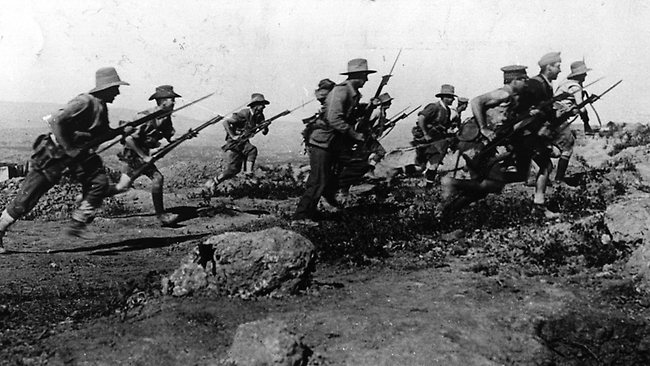At Gallipoli, Strong Turkish Resistance;
On Eastern Front, Russians Routed
Special to The Great War Project
(2-4 May) In this first week of May a century ago, the British proclaim they are doing well on the battlefield on several fronts.
But these are empty claims, as Turkish and German forces mount strong resistance against the British and the French, who have landed some 50,000 troops, mostly from Australia and New Zealand, on the Gallipoli Peninsula.
On May 3rd, Lord Kitchener, Britain’s Minister of War, informs the British War Council that there is “no doubt that we shall break through” in Gallipoli.
But the Turks “doggedly refused to let the invaders pass,” reports historian Eugene Rogan.
Neither Kitchener nor his Ottoman counterpart Enver Pasha can make good on their promises. Enver orders his troops, commanded by a German general, to “drive the invaders into the sea.” In that the Turks are unsuccessful. British and French forces establish two beachheads on the Gallipoli peninsula. But they are dangerously vulnerable.
One of the allied landings is at Cape Helles, at the southernmost tip of Gallipoli. “On the lower ground at Cape Helles,” writes war historian John Keegan…
“the days after the landing had been filled with savage fighting.”
“At Gallipoli as on the Western Front,” writes historian Martin Gilbert, “trenches and even ridges were to change hands again and again….with no perceptible change of the line” on the maps.
British leaders believe if they take Gallipoli and the Dardanelles waterway by its shores, the Allies can seize Constantinople, the Ottoman capital, and force the collapse of the Ottoman Empire. That would spark a crisis in both Berlin and Vienna and perhaps even force an end to the war.
But the British prove far too optimistic.
The same night in May 1915 that Kitchener makes his promise to the British War Council, the Turks launch a fierce attack on the British invaders at Cape Helles.
On these days a century ago, reports Rogan, the Turks attack allied positions and lose 6,000 dead and wounded. Then the Turks mount a second attack losing “another 4,000 soldiers – losses of 40 percent in just ten hours.”
“Ill luck and error,” reports historian Gilbert, “followed by the unexpected vigor of the Turkish defenders…
…shattered the Allied dream of a turning point that would bring them both victory in the field and territory on the map.”
Also in the first week of May, 1915, Germany and Austria-Hungary are on the offensive on the Eastern Front. Their goal: to drive the Russians out of the Carpathian Mountains where the Russians had been so successful in the previous winter.
“The main attack,” writes Gilbert, “was preceded by a 610-gun bombardment, the largest barrage yet attempted on the Eastern Front.”
The artillery barrage includes poison gas shells. Gilbert reports that 700,000 shells are fired in a four-hour bombardment. In one day, the Russians withdraw from the Polish town of Gorlice. Soon after that, the Germans drive the Russians out of another Polish town, Tarnow.
“Thousands of Russian soldiers lay dead on the battlefield,” reports Gilbert.
“Nine months of victorious Russian advances were over.”
A British nurse named Florence Farmborough is serving with a Russian unit during the fighting and is witness to the terrible suffering of wounded Russian soldiers.
She writes in gut-wrenching detail of one soldier. “I pushed the clothes back and saw a pulp, a mere mass of smashed body from the ribs downwards; the stomach and abdomen were completely crushed and his left leg was hanging to the pulped body by only a few shreds of flesh.”
“What it cost me to turn away without aiding him, I cannot describe, but we could not waste time and material on hopeless cases, and there were so many others waiting.”
Elsewhere, on the open sea, the luxury ocean liner Lusitania with some 2000 people on board, is halfway across the Atlantic, due in Liverpool in another three days.


